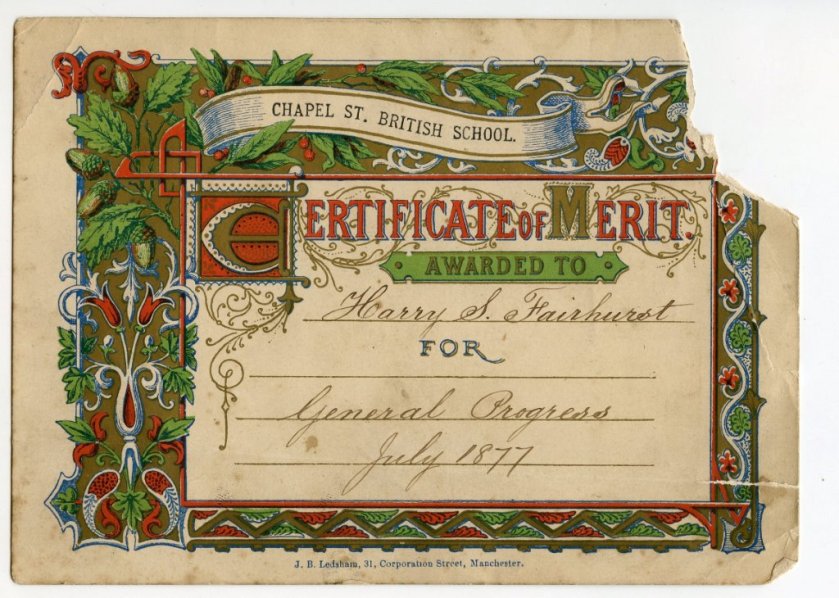The exhibition ‘We built this city’, currently on display in our gallery, includes plans and drawings of some of the buildings designed by the company established by the eminent Manchester architect, Sir Harry S. Fairhurst. Fairhurst established Harry S. Fairhurst & Son in Manchester in 1901, in partnership with James Harold France. The practice went on to design some of Manchester’s great warehouse buildings including Bridgewater House and India House as well as major buildings such as Arkwright House and Lee House. Fairhurst was the President of the Manchester Society of Architects from 1926 – 1928.
 By coincidence, staff in MMU Special Collections have recently come across what may be a rather more modest record of this significant figure in the building of this city. Whilst rehousing some material from our 19th and 20th century commercial print collections, we noticed the name that was written on an example of the sort of colourful, chromolithographically printed ‘reward’ or ‘certificate of merit’ cards that were awarded to school pupils in the 19th and 20th centuries. The card, now rather battered and torn, was awarded in 1877 at the ‘British School, Chapel Street’ for ‘General Progress’ to a Harry S. Fairhurst. Was this the Harry S. Fairhurst? The date is right, as he would have been nine at the time. The location is, at least possibly, right as there is a Chapel Street in Blackburn, Lancashire, where Fairhurst grew up, although we have not yet been able to find a record of the school that issued the card.
By coincidence, staff in MMU Special Collections have recently come across what may be a rather more modest record of this significant figure in the building of this city. Whilst rehousing some material from our 19th and 20th century commercial print collections, we noticed the name that was written on an example of the sort of colourful, chromolithographically printed ‘reward’ or ‘certificate of merit’ cards that were awarded to school pupils in the 19th and 20th centuries. The card, now rather battered and torn, was awarded in 1877 at the ‘British School, Chapel Street’ for ‘General Progress’ to a Harry S. Fairhurst. Was this the Harry S. Fairhurst? The date is right, as he would have been nine at the time. The location is, at least possibly, right as there is a Chapel Street in Blackburn, Lancashire, where Fairhurst grew up, although we have not yet been able to find a record of the school that issued the card.
The coincidences seem sufficient to conclude that it is very likely that the young boy who received this card was indeed the architect responsible for so many landmark Manchester buildings. Of course the next question is how it came to be in the Special Collections at MMU? This, despite our high standards of documentation and record keeping, is a question we cannot yet answer. We hold a number of this type of object, although they were collected as examples of the printing techniques of the 19th century not because of the identity of the recipient. Could it be coincidence that one of these cards just happened to have been awarded to a figure who appears so prominently in our current exhibition? Or, was the card given to us specifically because it had been awarded to Fairhurst, and the record of the significance of the donation has been lost? Either way it’s a nice example of the sorts of interesting and curious associations between items that can sometimes occur within collections as diverse, complex and wide-ranging as those held at MMU Special Collections.